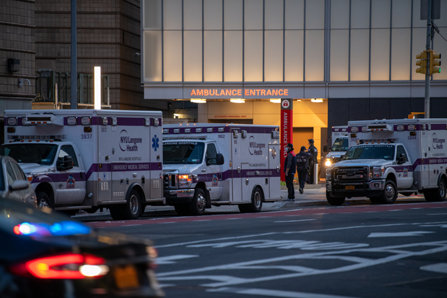The Drug Overdose Epidemic

While deaths from COVID-19 are front-page news on a daily basis, another national public health crisis, overdose deaths from the use of illicit drugs, is growing. For many, the correlation represents strong evidence that another painful result of the pandemic is an increase in deaths from drug addiction.
More than 750,000 people have died since 1999 from a drug overdose. According to the Centers for Disease Control and Prevention (CDC), there were 67,367 drug overdose deaths in 2018, 46,802 (69.5%) of those involved opioids and two out of three opioid-involved overdose deaths involved synthetic opioids (excluding methadone). Synthetic opioids include Demerol, Lortab, fentanyl and carfentanil.
During the first three months of 2020, an estimated 19,416 individuals died of a drug overdose in the United States compared with 16,682 in the same three-month period in 2019—a 16.4% increase, according to data released in October 2020 by the CDC’s National Center for Health Statistics. This agency also estimates that 75,500 overdose deaths occurred between March 2019 and March 2020, which is an increase of close to 10%.
If this increased rate for drug overdose deaths continues, the United States will hit a new all-time record for overdose fatalities within a calendar year. Most states experienced increases in the rate of overdose deaths during the first quarter of 2020 compared with the same period in 2019, with 7 states plus the District of Columbia experiencing increases ranging from 25% to 50% from March 2019 to March 2020.
Other than a small decline in 2018, overdose fatalities have increased dramatically for the past three decades, with a record number of 71,966 estimated deaths in 2019, the majority of which involved opioids.
Beginning around 1999, the first wave of opioid overdose deaths involved prescription opioids (including methadone), following increased prescribing of opioids in the 1990s. Starting in 2010, rapid increases in overdose deaths involved heroin, then starting in 2013, the significant increases in fatalities were fueled by synthetic opioids (especially the highly potent fentanyl).
According to the United States Drug Enforcement Administration (DEA), Fentanyl is a synthetic opioid that is 80-100 times stronger than morphine. Pharmaceutical fentanyl was developed for pain management. Because of its powerful opioid properties, Fentanyl is diverted for abuse and is added to heroin to increase its potency, disguising it as highly potent heroin. Many users believe that they are purchasing heroin, not knowing that they are purchasing fentanyl—which often results in overdose deaths.
Reports from law enforcement indicate that much of the synthetic opioid overdose increase may be due to illegally or illicitly made fentanyl, according to the CDC. Per data from the National Forensic Laboratory Information System (NFLIS), confiscations, or seizures, of fentanyl increased by nearly 7 fold from 2012 to 2014. There were 4,585 fentanyl confiscations in 2014. This suggests that the sharp rise in fentanyl-related deaths may be due to increased availability of illegally made, non-pharmaceutical fentanyl, and not prescribed fentanyl.
Are People Coping with COVID-19 by Taking Drugs?

The latest rise in fatal drug overdoses may be related to the COVID-19 pandemic. According to findings from a CDC survey of US adults in June 2020, 13% of respondents said that they had started or increased substance use to cope with pandemic-related stress or emotions. The group most likely to do so was young adults (nearly a quarter of those aged 18 to 24 years).
The Washington/Baltimore High-Intensity Drug Trafficking Area (W/B HIDTA) is housed within the University of Baltimore Center for Drug Policy and Enforcement (CDPE). It developed and maintains the Overdose Detection Mapping Application Program (ODMAP), a syndromic surveillance system that provides near real-time suspected overdose data nationally.
In a June 2020 W/B HIDTA report the following information came to light:
- After March 19, 2020, 61.84 percent of participating counties experienced an increase in overdose submissions;
and:
- There was a 17.59 percent increase in suspected overdose submissions when comparing the weeks prior to and following the commencement of state-mandated stay-at-home orders.
At the same time, news media suggest that individuals struggling with substance abuse may face difficulties in getting help.
Kaiser Health News reported in July 2020 that some drug rehabilitation programs were forced to close down or limit their operations because of COVID-19 cases among patients or staff, or financial difficulties stemming from the pandemic.
But the overdose epidemic rages strong.
The evidence shows that COVID-19 is accelerating an already devastating problem. Whether the increases stem from a lack of access to treatment or as a mechanism to cope with the horrors presented by a raging virus and solitary confinement during lockdowns, the accelerating crisis provides a disturbing reality for anyone struggling with an addiction.
Sources:
- https://www.cdc.gov/nchs/health_policy/mortality.htm
- https://www.cdc.gov/drugoverdose/data/statedeaths.html
- http://www.odmap.org/Content/docs/news/2020/ODMAP-Report-June-2020.pdf
- https://khn.org/news/coronavirus-crisis-disrupts-treatment-for-another-epidemic-addiction/
- https://www.dea.gov/factsheets/fentanyl


